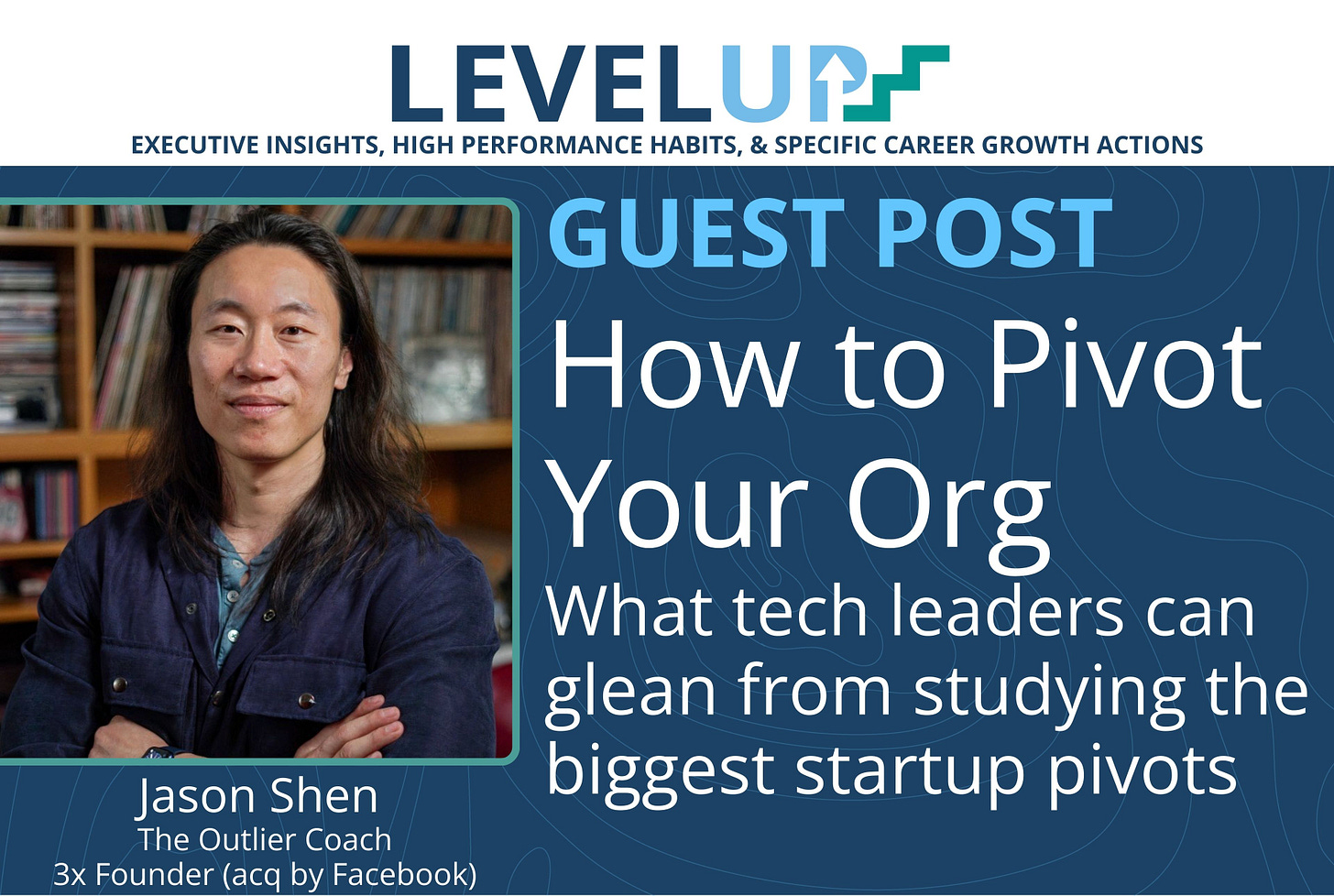How to Pivot Your Org—What tech leaders can glean from studying the biggest startup pivots
Learn from Etsy, Facebook, Hugging Face, Notion, Apple, Intel, Medium, and Nuvocargo's pivots.
Hello, it’s Ethan & Jason. Welcome to a *paid subscriber-only* edition of Level Up: Your source for executive insights, high performance habits, and specific career growth actions.
Many subscribers expense this newsletter to their Learning & Development budget, here’s an email template to send to your manager.
If you are not a paid subscriber, here’s popular articles you missed:
We are thrilled to bring you a guest post by Jason Shen. Before he became an executive coach, Jason was a 3x founder (acquired by Facebook) and product manager at Etsy and Facebook. In this article, Jason will share the three key steps to a successful pivot, using stories from his own career and examples from startup pivots you’ve heard of—and ones you haven’t. These lessons will ensure that your teams and companies stand the best chance at adapting in the face of disruptive change and emergent opportunities.
Jason knows firsthand just how hard it can be to get a struggling product, team, or division on the right track. That's why last year he published a book called The Path to Pivot, a playbook for founders who want to reboot their business (the strategies for these founders can also be applied by entrepreneurial operators inside tech companies).
As every technologist knows, iteration is a critical aspect of building anything great.
There were online payment gateways before Stripe, tablets before the iPad, and chatbots before OpenAI. Each product category went through years, even decades of iteration before hitting an S curve of growth.
But sometimes, iteration is not enough. Sometimes, you need a hard reset or a complete refactor.
In the startup world, pivots are a legendary tactic that have created some of our best-known companies. Floodgate cofounder Mike Maples recently claimed that 80% of the companies in his portfolio that achieved breakout success found that success through pivots.
But pivots aren't just the domain of founders and entrepreneurs. They are a tool that can be leveraged by technology leaders as well. Two notable examples of pivots in leading tech companies are Intel's major pivot from memory chips into CPUs and Microsoft's pivot from desktop software to the internet, and later, to AI.
What is a pivot?
For a startup, a pivot is a significant shift in strategy and resource allocation as seen in the product, the target customer, the problem addressed, or the business model. For an entrepreneurial operator, it means focusing on a different segment of your existing customers, choosing to compete in a different market, or altering your roadmap in anticipation of technological or economic shifts.
A successful pivot requires three steps:
Align: Get leadership to realize that the current trajectory of the company is untenable and that a major strategic shift is required.
Explore: Create space to test new ideas and strategies, focus on the company’s strongest assets, and meet real customer needs.
Commit: Gain conviction on a new approach and swing hard in that direction.
Now, let’s examine each of these three steps in detail.

1. Align
A successful corporate pivot requires alignment among the leadership, and, ultimately, with the rest of the team.
I joined the ecommerce marketplace Etsy as a product manager on the seller experience team in the summer 2015, a few months after the company’s IPO. Etsy had historically seen massive ROI in building tools and programs for the millions of indie handmade, vintage, and craft sellers that operated storefronts on the online marketplace. Our motto was: "If we take care of sellers, sellers take care of us."
This flywheel worked for years as enthusiastic sellers recruited their friends to the platform and pointed their interested buyers towards our site—creating customers we could remarket to with new offerings. Etsy also built out additional revenue streams like shipping labels and search advertising, that nearly equaled revenue from listing and transaction fees.
However, as Etsy grew, the cracks began to appear. Big seller-facing investments that focused on connecting sellers with retailers and responsible manufacturers weren’t paying off as we had hoped. In addition, the search feature on the platform was a consistent issue, and our choice to operate our own web servers seemed unbefitting of a public company. Wall Street’s grumbles got louder and louder.
Etsy was headed towards a major pivot, and like all pivots, the company needed to align on a new direction. All eyes were on the board and then-CEO Chad Dickerson to chart the way forward. However, trepidation lingered in the air.
Chad had grown Etsy’s revenues 14x and led the company through the 2015 IPO. He was also a father figure for many within the company, and his kind and thoughtful manner embodied the Etsy way. So, many of us were surprised when at the end-of-year all-hands meetings (we called it Y’all Hands), Chad spoke ominously of having not proven that Etsy could truly “do good while doing well”—aka be a socially responsible company that also makes money. The stock price reflected his concerns, dipping more than 75% from its IPO bubble price of $27.
Shoot the Zombie
With a startup, replacing a founder can easily kill the entire venture, but as the organization grows, a new head can often stimulate change. In May of 2017, the Etsy board fired Chad Dickerson, replacing him with board member Josh Silverman—a move that echoed Chad’s own elevation to CEO six years earlier. I still remember standing in shock with my colleagues watching Chad announce his departure in a companywide broadcast. In his final act as CEO, Chad also oversaw a 8% reduction in staff, our first-ever mass layoff, cutting 80 positions.
Taking steps like this is what makes pivots painful, which is why most organizations won’t engage in one until they absolutely have to. For a startup, this means confronting the fact that they cannot succeed as a venture-scale company given their current trajectory and growth rate.
How Hugging Face pulled the trigger.
Every wonder why AI platform Hugging Face has a 🤗 for a logo? The company began as an intelligent chatbot for teenagers, growing (and stalling out at) 100,000 users over two years. Not bad for a side project, but hardly enough to justify continued investment. The turning point came when Google released BERT in October 2018. Within a week, Hugging Face created and open-sourced a simplified PyTorch version of this complex language model. This move transformed Hugging Face from a middling consumer app into a beloved tool in the machine learning community. By “killing” their zombie app, the founding team committed to a bigger path, eventually building a platform that hosts 500k+ models and 250k+ applications.
Align Incrementally
Back to the Etsy story. Obviously, there’s a lot of discussion that goes into replacing a CEO—much of which happened behind closed doors at board meetings and in private conversations. However, it was likely a move by three different hedge funds that had acquired stakes in Etsy that finally tipped the board to make the change. The day after the former CEO made his departure and layoff announcement, he appeared onstage with his successor at a company-wide all hands. Josh Silverman’s initial attempt to build bonds with the company were underwhelming, and many veterans voluntarily left the company in light of the new leadership, putting Josh on the back foot as he attempted to pivot.
This is an example of failing to align incrementally.
Aligning incrementally is all about smart communication with your stakeholders, including your employees, about the need for change. And unfortunately—as my experience at Etsy affirms—the broader team is typically informed after what can be a contentious alignment process between the board, investors, and senior leadership.
As an example of how the alignment process can be navigated successfully, consider Nuvocargo founder Deepak Chhugani.
Nuvocargo’s cashback gamble
When Chhugani decided to pivot his Y Combinator-backed startup, a Wall Street recruiting company, he offered his investors a chance to take their money back—explaining that he had lost conviction in the business and wanted to explore something new. He was within his rights to forge on, but this offering built trust among his investors and the vast majority of them stayed invested in the venture. Their bet paid off. Nuvocargo, the shipping and logistics company he launched post-pivot, closed a $36.5M Series B raise this January and has become a significant player in the movement of goods between the US and Mexico.
2. Explore
It’s extremely rare that a leadership team is able to pivot immediately into a successful new direction—a phase of experimentation and discovery is typically necessary. But to do that, you need to give yourself space, time, and resources. Every senior leader should understand how crucial it is to make room in the budget for new possibilities.
Extend Runway
At Etsy, newly-appointed CEO Josh Silverman made dramatic moves to create this space. Just six weeks into his tenure, he initiated a second round of layoffs that cut another 140 positions. Along with the voluntary departures following the leadership change, these cuts reduced Etsy's workforce to just 60% of its original size. This painful but necessary restructuring lowered overhead significantly and gave the company crucial financial runway to experiment with new strategies and invest in critical areas like search functionality and marketplace operations. The leaner organization could move faster and more decisively, setting the stage for the remarkable turnaround that would follow.
These same strategies can be seen in some of the most popular startups today:
Notion's retreat to Japan
The Notion founders took four years to reach product-market fit, starting with a no-code tool builder that was far too complicated for its target users. After the first version of their product failed to gain traction, cofounders Ivan Zhao and Simon Last let go of their 4 person team and relocated to Kyoto to hunker down for a pivot. This move allowed them to massively cut expenses and gave them the resources to rebuild a product from scratch without raising additional capital. Today, Notion is valued at over $10 billion.
But, pivot strategies like this aren’t just for startups. Even the biggest companies with significant financial cushion still have to find ways to trim down, and executives will often look for particularly bloated departments to target. Teams that have expanded through previous periods of growth but can't demonstrate clear value alignment with the company's new direction become natural candidates for restructuring. This is especially true for experimental initiatives or "innovation labs" that might have made sense during boom times but become harder to justify during a strategic reset.
Facebook's Reset
In 2020, I joined Meta through the acquisition of my AI gaming startup Midgame. As PM for public groups—a Reddit-like product with 400M+ daily users—I was part of a massive 1,500-person Facebook Groups organization. Despite positive experiments and being considered "the only good thing left" about Facebook, Groups was seeing declining usage and many major initiatives weren't succeeding. The economic downturn and TikTok competition led to Meta's first-ever layoffs in late 2022, followed by more cuts in 2023. Groups was significantly impacted, with numerous projects being shut down.
Interestingly, the elimination of many teams and projects created space for new ideas to flourish—ideas that would have previously conflicted with existing work and been immediately dismissed. New teams were drawn up, laser-focused on either suggesting more relevant groups for users to join or ways to encourage new posts or comments within Groups. While I don’t have the most up-to-date numbers on Facebook Groups, a recent update from Meta indicated that 1.8 billion people engage with Groups on a monthly basis, making it one of the most popular social media products of all time.
Narrow Down
Pivots often require making hard choices about what to stop doing. For bigger companies especially, success can come from narrowing focus rather than expanding it—cutting away initiatives that scatter resources and attention.
At Etsy, Silverman's strategy exemplified this principle. Rather than trying to be everything to everyone, he made the difficult decision to concentrate on core marketplace dynamics. This meant significantly reducing investment in secondary initiatives like the seller-focused programs that had been a cornerstone of Etsy's identity. The restructuring had a personal impact on me and many colleagues as it resulted in another round of layoffs that hit our seller division heavily.
But this laser focus paid off. By redirecting resources toward improving the buyer experience and optimizing marketplace operations, Etsy was able to drive substantial growth in gross merchandise sales. The company streamlined its product development process, improved search functionality, and enhanced the overall shopping experience—changes that might not have been possible while maintaining numerous other initiatives. This strategic narrowing proved crucial to Etsy's successful transformation from a struggling public company to an e-commerce powerhouse.
How Apple got focused
When Steve Jobs returned to drowning Apple in 1997, he made a bold decision: slash the bloated product line from 350 products to just 10. The strategy worked brilliantly. Within a year, Apple transformed from a company losing $1B annually to one earning $300M, simply by focusing on great desktops and laptops in consumer and professional versions. By doing less and selling fewer items, Apple increased quality and concentrated its efforts on its most profitable and strategically important products. Three years later, they introduced the iPod, and the rest is history.
3. Commit
The final act of a pivot is when, after careful deliberation, the person in charge must follow through on a new approach with unwavering conviction. Silverman's commitment to Etsy's new direction was absolute and the results were transformative.
Make the Call
Etsy streamlined its product development process, completely overhauled its search functionality, and enhanced the overall shopping experience. In a particularly significant move, they migrated their infrastructure from self-managed data centers to Google Cloud—abandoning what had been a point of pride among Etsy engineers who had long championed "owning our own metal." While controversial, this decision dramatically improved the site's reliability and accelerated development speed.
The laser focus on core marketplace dynamics paid off dramatically. Within 24 months of the strategic reset, Etsy's stock had climbed an astounding 1330%. These changes—which might not have been possible while maintaining numerous other initiatives—helped Etsy reach new heights, eventually achieving a peak valuation of $33B during the pandemic.






